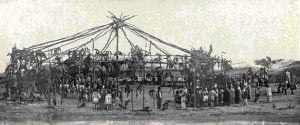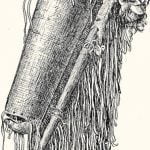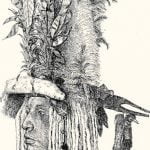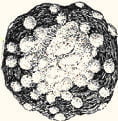
Tribal Ceremonies. In addition to the above ceremonial practices, there are a number of procedures deserving special mention. Most tribes had a series of ceremonies for calling the buffalo and inducing them to enter the pound or to permit themselves to be easily taken by the hunters. These have not been satisfactorily investigated but seem to have varied a great deal probably because this function was usually delegated to a few tribal shamans each of whom exercised his own special formulae. The Crow, the Blackfoot, and perhaps a few other tribes had elaborate tobacco planting ceremonies. The Pawnee formerly sacrificed a captured maiden in a ceremony to the Morningstar, the procedure showing close parallels to Aztec practices, and some of the maize-growing tribes in this area are credited with a “green corn” or harvest dance, a characteristic of the tribes east of the Mississippi. The Pawnee also maintained some curious ceremonies in which shamans performed remarkable tricks and demonstrated their magical powers. Turning from these rather exceptional practices, we find certain highly typical ceremonies.
The Sun Dance

One of the most important tribal ceremonies is the so-called sun dance. The name as used in literature is probably derived from the Dakota w r ho speak of one phase of the ceremony as sun-gaze-dancing: i. e., the worshipper gazes steadily at the sun while dancing. To a less extent, this is one of the objective features of the ceremony wherever performed and is occasionally associated with a torture feature in which skewers are thrust through the skin of the breast and back and the devotee suspended or required to dance until the skin gives away, all the time supplicating the sun for divine guidance.
Another feature is that in the center of the ceremonial place is set up a tree, or sun pole, which is scouted for, counted coup upon, and felled, as if it were an enemy. Upon this, offerings of cloth are made to the sun. In the fork at the top is usually a bunch of twigs, in some cases called the nest of the thunderbird. With in the enclosure on the left side an altar is made.
The time of the sun dance is in midsummer. It is usually initiated by the vow of a man or woman to make it as a sacrifice in return for some heeded prayer in time of great danger. The soldier societies, the women s society, and other organizations, generally take turns dancing at the sun pole after the above named rites have been concluded. As a rule all who perform important functions in the sun dance are required to spend several days in fasting and other purification ceremonies.

Some form of sun dance has been reported for all the tribes of this area except the Comanche, Omaha, Iowa, Kansa, Missouri, Osage, Oto, Pawnee, Wichita, Bannock, and Nez Perce: that even some of these formerly practiced it, is probable. The Mandan had an elaborate ceremony known as the Okipa, fully described by George Catlin who visited that tribe in 1832. This is not a sun dance, but contains the self-torture practiced by the Dakota.
When we consider the total distribution of the sun dance it appears that its ceremonial complex, like that for soldier societies, presents several features variously combined and distributed. These are the torture, the circular shelter of poles, the use of a sacred bundle, the altar, the erection of a sun pole, and the dancing ceremonies. The form of shelter shown in the Arapaho model has been observed among the Arapaho, Gros Ventre, Kiowa, Ute, Shoshoni, Plains-Ojibway, Cheyenne, Blackfoot, Sarsi, Plains-Cree, and Hidatsa. With the possible exception of the Plains-Cree all used a sacred bundle of some form. (For examples see the Blackfoot and Crow collections.) The Crow used a bundle containing an image, but a different form of shelter. The Ponca and Dakota used no bundles but a shelter of another type from that shown in the model, but both had the torture, sun-gaze-dancing, and the sun pole.
Ghost Dance Ceremonies
Even within historic times, there have been several interesting religious developments among the Plains Indians. The most noted of these was the ghost dance. This was a religious ceremony founded upon the belief in the coming of a Messiah, which seems to have originated among the Paviotso Indians in Nevada (Plateau area) about 1888 and which spread rapidly among the Indians of the Plains. The prophet of the religion was a young Paiute Indian (Plateau Area) who claimed to have had a revelation while in a delirious condition caused by an attack of fever. The Teton-Dakota seem to have first heard of the new religion in 1889 and in a council held by Red-cloud, appointed a committee to visit the prophet and investigate. On this committee were Short-bull and Kicking-bear, who returned very enthusiastic converts and began preaching the new religion among the Dakota. The principal belief was that an Indian Messiah was about to appear to destroy the white race, and restore the buffalo with all former customs. As in all Indian ceremonies, dancing played a large part, but in this case the dancers usually fell into a hypnotic trance and upon recovering recounted their visions and supernatural experiences. All participants were provided with decorated cloth garments bearing symbolic designs which were believed to have such relation with the coming Messiah that all who wore them would be protected from all harm. Among white people these garments were generally known as “bullet proof shirts” (see Dakota collections).
The enthusiasm over the new ghost dance religion spread over the several Dakota Indian reservations, resulting in the attempted arrest and killing of the famous Sitting-bull by the Indian police and hostile demonstrations on the Pine Ridge Reservation, under the leadership of Short-bull and Kicking-bear. In consequence, United States troops were concentrated on the Pine Ridge Reservation under the command of General Nelson A. Miles. The hostility of the Indians increased until December 29, 1890, when there was an engagement between Big-foot’s band and the command of Colonel Forsyth on Wounded Knee Creek, in which thirty-one soldiers and one hundred twenty-eight Indians were killed. In a short time after this decisive engagement, practically all the Indians laid down their arms and abandoned the ghost dance religion. It is probable, however, that some of the ceremonies connected with the ghost dance religion are performed even to this day, since several of the leaders are still living.
Practically all of the typical tribes took up the new beliefs about the same time but no where else did the excitement lead to violence. Among the Cheyenne, Arapaho, and Gros Ventre, the ceremonies still exist in a modified form, apparently combined with the Omaha or grass dance.
Peyote Worship

There are curious ceremonies connected with the eating or administering of the dried fruit of a small cactus (Anhalonium or Laphophora) , native of the lower Rio Grande and Mexico. The name “mescal” is wrongly applied to this fruit by many white observers. Long ago, these ceremonies seem to have been known to the Kiowa and Comanche of the Plains and widely distributed in the Southwest and Mexico. The rites begin in the evening and continue until the following dawn, and are restricted to men. There is a definite ritual, a small drum and rattle of special form being essential. Within the last few years, this worship has become general among the Arapaho, Cheyenne, Omaha, Dakota, and Kiowa, and threatens to supplant all other native ceremonies. It is even found among the Winnebago, Sauk and Fox, and Menominie of the Woodlands. This diffusion in historic times, makes it one of the most suggestive phenomena for students of Indian life, since it affords an indisputable example of culture diffusion.
Dancing Associations
There are a number of semi-religious festivals or ceremonies in which a large number of individuals participate and which seem to have been handed on from one tribe to another. The best known example of this is the Omaha or Grass dance which has been reported for the Arapaho, Pawnee, Omaha, Dakota, Crow, Gros Ventre, Assiniboin, and Blackfoot. The various tribes agree in their belief that this dance, and its regalia originated with the Pawnee. The Dakota claim to have obtained it directly from the Pawnee about 1870. The Arapaho and Gros Ventre claim to have learned it from the Dakota. The Gros Ventre taught it to the Blackfoot about 1883. Though these statements of the Indians are not to be taken as absolutely correct, they indicate that this dance is a modern innovation. Recently, the Blackfoot have carried the dance to the Flathead and Kootenai tribes to the west.
The meetings are held at night in large circular wooden buildings erected for that purpose. Some of the dancers wear large feather bustles, called crow belts, and peculiar roached headdresses of hair. A feast of dog’s flesh is served at which many members formally give away property to the poor. They even go so far now and then, as to formally put away a wife as the greatest act of self-denial.
In the same class may be mentioned the kissing or hugging dance, sometimes called the Cree dance. This seems to have come from the north and resembles a form of dance once common among the half-breed Canadians. In the Plains, however, it has Indian songs and other undoubtedly native features. To this list may be added the tea dances, the horseback dances, etc.
Among these Indians each distinct ceremony or dance has its own peculiar set of songs to which additions are made from time to time.
War and Scalp Dances
The scalp or some other part of the foe was often carried home and given to the women of the family who made a feast and danced in public with songs and cheers for the victors. A party about to go to war would gather in the evening, sing, dance, and observe certain religious rites to ensure success. In all of these there seems to have been little that was distinctive or peculiar to the Plains.
Ceremonial Procedure
It is rather difficult to characterize satisfactorily the many detailed ceremonies of the Plains, but some points are clear. Inmost we find an inordinate amount of singing, often extending over an entire day and night, interspersed with prayers and the handling of sacred objects or bundles and occasional dancing. The sweat house is used for preliminary purification and incense is burned at intervals during the ceremony. The participants usually sit in a circle with a fire at the center. A man leads and has the entire direction of the ritual, other men and perhaps women assisting him. A kind of altar or earth painting is common. This is usually a small square of fresh earth between the leader and the fire upon which symbols are made by dropping dry paint, suggesting the sand painting of the Navajo, but otherwise highly individual in character. In the manipulation of ceremonial objects we often observe four movements, or three feints before anything is done. Again, many objects are not put down directly but moved around in a sunwise direction. All such manipulations are likely to be common to all ceremonies and therefore not distinctive or significant. It is not far wrong to say that all these ceremonies are demonstrations of the ritual associated with some bundle or objects and represent the original visions or experiences in which the whole was handed down. The demonstration seems to be ordered on the theory, that, as in the original revelation, the divine element will be present in the objects and appurtenances thereto. The persons participating are rather passive. We have practically no attempts to impersonate and to act out in detail the parts played by supernatural beings. This is shown in the almost entire absence of masks and ceremonial costume. Thus, among the Indians of the North Pacific area, the Pueblos of the Southwest, and the Iroquois of the Woodlands, we find persons in ceremonies dressed and masked to represent the various gods or supernatural creatures and who act out parts of the ritual. Even among the Navajo and the Apache of the Southwest, these costumes play a conspicuous part. All this is rare in the strictly religious ceremonies of the Plains and brings out by contrast what is perhaps one of their most characteristic features.
Painting the face and body and the use of a pipe are also highly developed elements. In most cases, there is a distinct painting for each ceremony, again supposed to be according to the directions of the initial revelation. A lighted pipe is not only frequently passed during a ceremony but is also filled to the accompaniment of ceremonial movements and offered with prayers to many or all of the recognized sources of the higher powers.
The only musical instruments used in these ceremonies are rattles, drums, and whistles.
